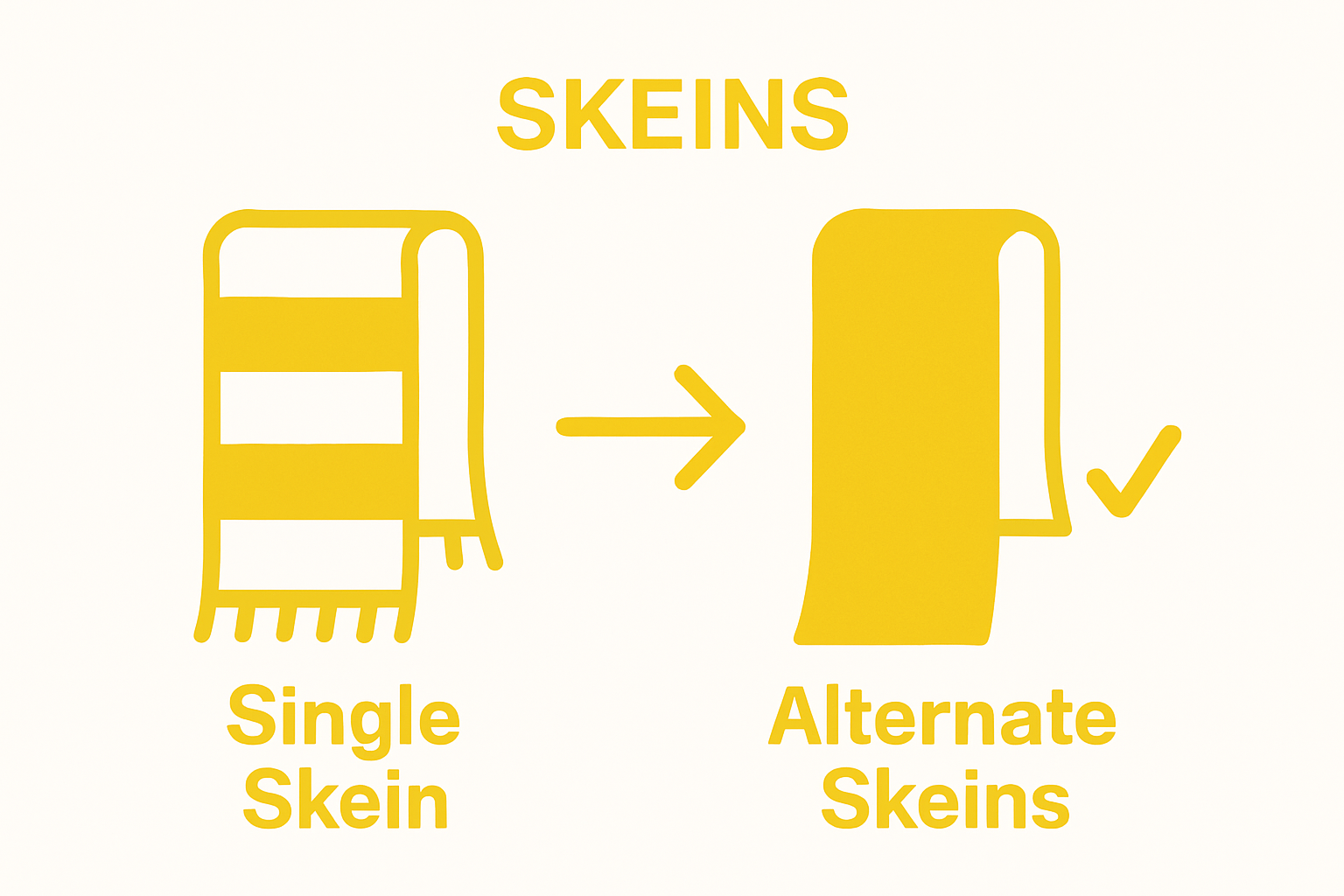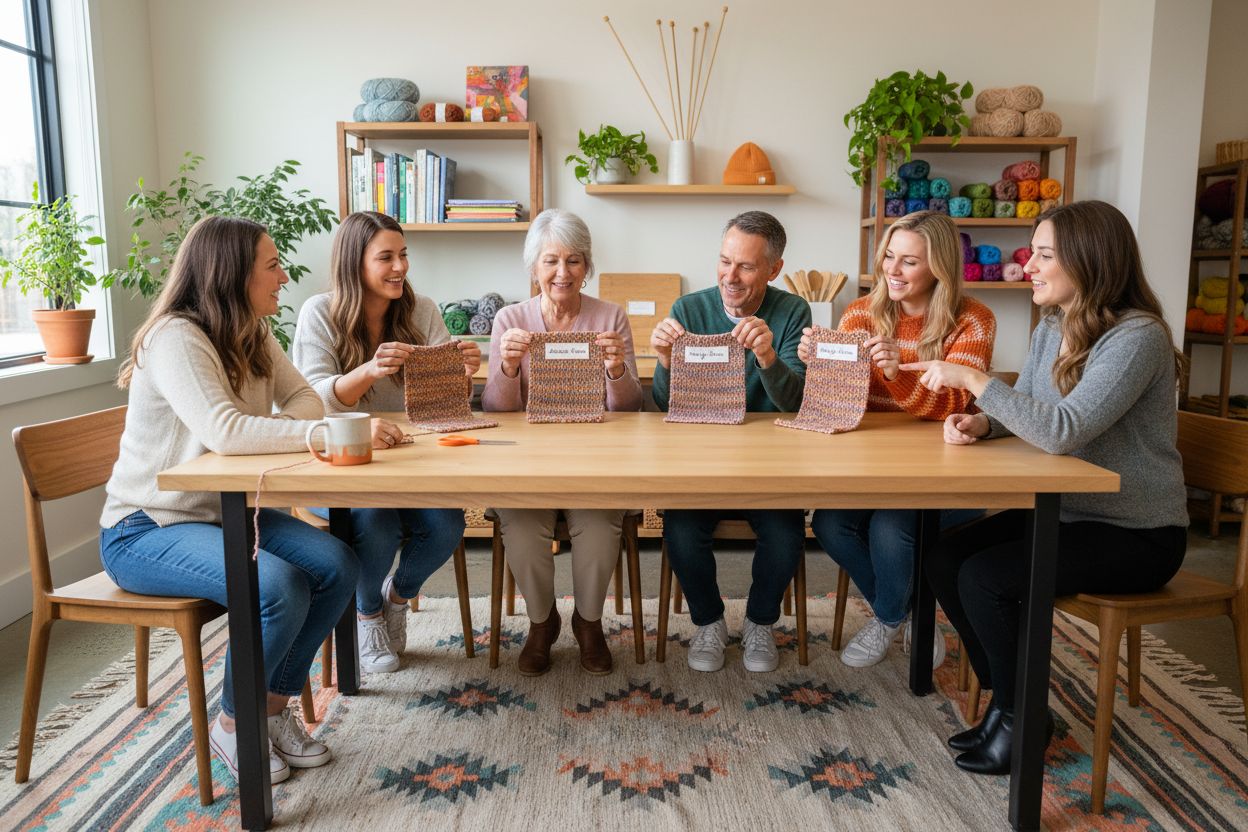
Understanding Why Alternate Skeins Matters in Knitting
Knitting with hand-dyed or natural yarns might look simple at first glance and it is easy to assume every skein will match perfectly. But even skeins from the same batch often hold hidden surprises. Color shifts can become especially noticeable in larger projects like sweaters or blankets and they can sneak up on you just when you thought everything was smooth sailing. Most knitters are tempted to just go skein by skein but the real trick is learning when and how to alternate them. This single move can change everything about how your final piece looks and feels.
Table of Contents
- What Are Alternate Skeins And When To Use Them?
- Why Alternate Skeins Can Prevent Color Pooling
- How Alternate Skeins Impact Yarn Consistency
- Key Benefits Of Alternating Skeins In Projects
Quick Summary
| Takeaway | Explanation |
|---|---|
| Alternate skeins ensure color consistency. | Use this technique to blend color variations, especially in hand-dyed yarns, for a uniform appearance. |
| Introduce new skeins regularly. | Change skeins every few rows to create gradual transitions and prevent noticeable color shifts. |
| Mitigate color pooling with skein management. | Alternating skeins can distribute colors evenly, helping avoid unintentional patterns in your work. |
| Maintain structural integrity with skein alternation. | This practice reduces tension inconsistencies and enhances the durability of knitted pieces. |
| Enhance visual appeal through coordinated colors. | By blending different skeins, the overall aesthetic improves, resulting in a more polished and intentional look. |
What Are Alternate Skeins and When to Use Them?
Alternate skeins represent a critical technique in knitting that helps ensure color consistency and yarn uniformity throughout a project. When working with hand-dyed or naturally colored yarns, each skein can have subtle variations in shade and tone, which means using skeins sequentially without careful management can result in noticeable color transitions or uneven appearance.
Understanding Skein Variation
Yarn skeins, particularly those from small batch or hand-dyed producers, are rarely identical even when originating from the same dye lot. These variations emerge from multiple factors:
- Slight differences in dyeing temperature
- Variation in yarn saturation during coloring process
- Minor inconsistencies in dye mixture
- Individual spinner or dyer techniques
These nuanced differences might seem minimal, but they can dramatically impact the visual quality of your finished knitting project. Color shifts can become especially pronounced in larger items like sweaters, blankets, or garments requiring multiple skeins.
Practical Strategies for Alternating Skeins
The primary goal of alternating skeins is to blend potential color variations seamlessly. Knitters typically achieve this by strategically switching between two or more skeins during project construction. This method is particularly crucial when working with hand-dyed yarn from independent producers.
A recommended approach involves introducing a new skein every few rows or rounds, creating a gradual transition that masks potential color inconsistencies. By weaving in skeins systematically, knitters can create a more harmonious and professional-looking final product that appears intentionally designed rather than accidentally mottled.
To help clarify when and why to alternate skeins, the following table compares using a single skein at a time versus alternating skeins based on key qualities and outcomes.
| Approach | Color Consistency | Visual Appeal | Structural Integrity | Best For |
|---|---|---|---|---|
| Single Skein at a Time | Risk of color shifts and transitions | May have noticeable patches | Possible tension inconsistencies | Small projects or uniform commercial yarn |
| Alternating Skeins | Smooth, blended color throughout | Harmonious and professional | Consistent tension and durability | Large items or hand-dyed/natural yarn |
Whether you are creating a delicate shawl or a robust winter sweater, understanding and implementing skein alternation techniques will elevate the overall aesthetic and quality of your knitting projects.
Why Alternate Skeins Can Prevent Color Pooling
Color pooling represents a significant challenge in knitting projects, particularly when working with hand-dyed or variegated yarns. This phenomenon occurs when colors in a multicolored yarn concentrate in specific areas, creating unintended and often unappealing patterns that disrupt the intended design of a knitted piece.
What is Color Pooling?
Color pooling happens when yarn with multiple colors or color variations clusters together, forming distinct patches or blotches instead of a smooth, integrated color distribution. This typically emerges from the way colors are distributed within the yarn and how they interact with specific knitting techniques and stitch patterns. The result can transform a carefully planned project into an unintentionally mottled or streaky appearance.
Key factors contributing to color pooling include:
- Yarn color distribution
- Knitting tension
- Stitch pattern complexity
- Yarn weight and fiber characteristics
Strategies to Mitigate Color Pooling
Preventing color pooling requires strategic yarn management. Professional knitters recommend alternating skeins to create a more uniform color transition. By introducing different skeins at regular intervals, knitters can break up potential color concentrations and create a more balanced, intentional color presentation.
The technique involves carefully introducing new skeins every few rows, ensuring that color variations are dispersed throughout the project rather than clustering in specific areas. This method works particularly well with hand-dyed yarns, where color variations are more pronounced and unpredictable.
Knitters can also adjust their approach by changing stitch patterns, modifying knitting tension, or selecting yarns with more evenly distributed color variations. Understanding the inherent characteristics of your chosen yarn becomes crucial in preventing undesirable color pooling effects.
This table summarizes main factors contributing to color pooling and outlines ways knitters can mitigate these issues for more even color distribution.
| Factor Influencing Pooling | Effect on Knitting | Mitigation Strategy |
|---|---|---|
| Yarn color distribution | Causes clustered patches or streaks | Alternate skeins regularly |
| Knitting tension | Amplifies or diminishes pooling | Adjust tension as needed |
| Stitch pattern complexity | Certain patterns highlight pooling | Change stitch pattern |
| Yarn weight & fiber | Impacts how colors settle in fabric | Choose evenly dyed yarns |
How Alternate Skeins Impact Yarn Consistency
Yarn consistency represents more than just color uniformity it encompasses the complex interaction between fiber characteristics, spinning techniques, and knitting practices. Understanding how alternate skeins contribute to maintaining overall project quality is crucial for achieving professional results in knitting.
Fiber Characteristics and Consistency
Each skein of yarn possesses unique microscopic variations that can significantly influence the final texture and appearance of a knitted piece. These subtle differences emerge from multiple production factors, including:
- Fiber source and processing methods
- Spinning tension and technique
- Environmental conditions during production
- Individual spinner or mill variations
These nuanced variations might seem imperceptible initially but can create substantial differences in yarn behavior during knitting. Understanding yarn gauge becomes essential in recognizing how these microscopic differences translate into broader textile performance.
Impact on Project Structural Integrity
Alternating skeins goes beyond aesthetic considerations. The technique plays a critical role in maintaining the structural consistency of a knitting project. By strategically introducing different skeins, knitters can distribute potential variations in yarn thickness, tension, and fiber alignment.
This approach prevents localized stress concentrations that might emerge from using a single skein continuously. Consistent skein alternation ensures more uniform tension and reduces the likelihood of unintended texture changes throughout the project.
Professional knitters recognize that yarn consistency directly influences a project’s durability, drape, and overall visual appeal. By implementing careful skein management, crafters can transform potentially unpredictable yarn characteristics into a cohesive, professional-looking finished piece.
Key Benefits of Alternating Skeins in Projects
Knitting is an art form that demands precision and attention to detail, with skein alternation emerging as a sophisticated technique that transforms potential yarn inconsistencies into deliberate design elements. Understanding the nuanced benefits of this approach elevates a knitter’s craft from amateur to professional.
Visual Harmony and Color Consistency
Color variation can dramatically impact a project’s aesthetic appeal, particularly in hand-dyed or variegated yarns. Alternating skeins creates a more harmonious visual texture by distributing color variations evenly. This technique prevents abrupt color transitions that might otherwise disrupt the intended design.

Key visual benefits include:
- Smoother color gradients
- Reduced likelihood of distinct color patches
- More professional and intentional appearance
- Enhanced visual depth and complexity
Structural Integrity and Performance
Beyond aesthetic considerations, alternating skeins significantly contributes to a project’s structural consistency. Understanding different yarn weights becomes crucial in recognizing how microscopic variations can impact overall textile performance.
The technique prevents potential weak points that might emerge from continuous use of a single skein. By distributing yarn characteristics throughout the project, knitters ensure more uniform tension, reduced stress concentration, and improved long-term durability.
Professional knitters recognize that strategic skein management is not merely a technical detail but a fundamental approach to creating high-quality, resilient textile pieces.
 Through careful alternation, crafters transform potentially unpredictable yarn characteristics into a cohesive, intentional design that speaks to skill and understanding of textile dynamics.
Through careful alternation, crafters transform potentially unpredictable yarn characteristics into a cohesive, intentional design that speaks to skill and understanding of textile dynamics.
Take the Guesswork Out of Skein Alternation with Craftiss Yarn Solutions
Are you frustrated by unpredictable color shifts or uneven texture when working with multiple skeins? Mastering how to alternate skeins is essential for any knitter who wants seamless color transitions and reliable project quality. At CRAFTISS Yarn, we understand the importance of skein consistency and offer curated hand-dyed and batch-consistent yarns, so you can create with confidence and precision.
.png)
Ready to achieve flawless results and prevent color pooling in your next project? Explore our range of premium yarns and knitting essentials right on CRAFTISS. Shop today and take the first step toward professional, beautiful projects. Need to keep your yarns safe and organized as you alternate skeins? Discover our Yarn Bags for smart storage solutions. The time to transform your knitting experience is now.
Frequently Asked Questions
What are alternate skeins in knitting?
Alternate skeins refer to the technique of using two or more skeins of yarn in a project by switching between them at intervals. This helps to blend color variations and ensures a more uniform appearance throughout the finished piece.
Why is it important to alternate skeins when using hand-dyed yarn?
Hand-dyed yarns often have subtle differences in color even within the same dye lot. Alternating skeins helps distribute these variations evenly, preventing noticeable color transitions and ensuring a more cohesive look.
How can I prevent color pooling when knitting?
To prevent color pooling, use the technique of alternating skeins regularly throughout your project. Introducing different skeins every few rows can help break up clusters of color and create a balanced color distribution.
What are the benefits of using alternate skeins in my knitting projects?
Using alternate skeins improves visual harmony by creating smoother color gradients, enhances structural integrity by distributing yarn characteristics and tension evenly, and reduces the likelihood of creating unintentional color patches in your work.


